
USS Bunch (DE-694) was a Buckley-class destroyer escort of the United States Navy, named after Kenneth Cecil Bunch, killed in action on 6 June 1942 while flying as radioman-gunner in an SBD Dauntless dive bomber during the Battle of Midway. Bunch was a native of Norman County, Minnesota.

USS Pitt (APA-223/LPA-223) was a Haskell-class attack transport in service with the United States Navy from 1944 to 1947. She was scrapped in 1980.

USS Grumium (AK-112/IX-174/AVS-3) was a Crater-class cargo ship and aviation supply ship in the service of the US Navy in World War II. Named after the star Grumium in the constellation Draco, it was the only ship of the Navy to bear this name.

USS Ottawa (AKA-101) was a Tolland-class attack cargo ship in service with the United States Navy from 1945 to 1947. She was sold into commercial service and was lost in 1951.
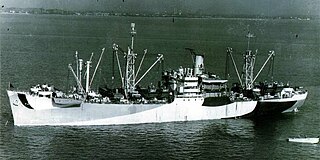
USS Suffolk (AKA-69) was a Tolland-class attack cargo ship in service with the United States Navy from 1944 to 1946. She was sold into commercial service and was scrapped in 1971.

USS Venango (AKA-82) was a Tolland-class attack cargo ship in service with the United States Navy from 1945 to 1946. She was sold into commercial service and was scrapped in 1971.

USS Waukesha (AKA-84) was a Tolland-class attack cargo ship in service with the United States Navy from 1945 to 1946. She was sold into commercial service and was scrapped in 1970.

USS Woodford (AKA-86) was a Tolland-class attack cargo ship in service with the United States Navy from 1945 to 1946. She was sold into commercial service and was scrapped in 1973.
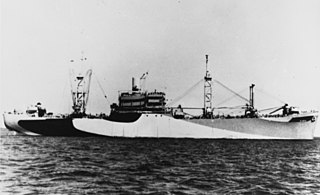
USS Tolland (AKA-64) was the lead ship of her class of attack cargo ships of the United States Navy. Named after Tolland County, Connecticut, she was designed to carry military cargo and landing craft, and to use the latter to land weapons, supplies, and Marines on enemy shores during amphibious operations. USS Tolland served as a commissioned ship for 21 months.

USS Thomas E. Fraser (DD-736/DM-24) was a Robert H. Smith-class destroyer minelayer in the United States Navy.
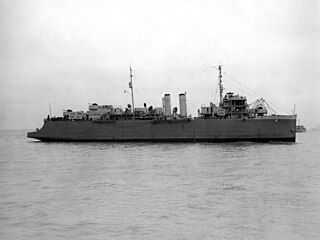
USS Weehawken (CM-12) was originally SS Estrada Palma – a car ferry built in 1920 by William Cramp & Sons of Philadelphia. It was acquired by the United States Navy on 15 June 1942; renamed Weehawken on 18 July 1942; converted to a minelayer by the Bethlehem Steel Co. at Hoboken, New Jersey; designated CM-12; and commissioned on 30 September 1942.
USS Recruit (AM-285) was an Admirable-class minesweeper built for the United States Navy during World War II. She was awarded 3 battle stars for service in the Pacific during World War II. She was decommissioned in August 1946 and placed in reserve. While she remained in reserve, Recruit was reclassified as MSF-285 in February 1955 but never reactivated. In 1963, she was sold to the Mexican Navy and renamed ARM DM-07. Although she is reported out of service, her ultimate fate is not reported in secondary sources.

USS Eastland (APA-163) was a Haskell-class attack transport in service with the United States Navy from 1944 to 1946 She was scrapped in 1974.

USS Gosper (APA-170) was a Haskell-class attack transport in service with the United States Navy from 1944 to 1946. She was scrapped in 1974.
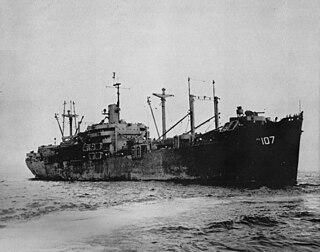
USS Goodhue (APA-107) was a Bayfield-class attack transport in service with the United States Navy from 1944 to 1946. She was sold into commercial service in 1947 and was scrapped in 1982.

USS Natrona (APA-214) was a Haskell-class attack transport of the US Navy in World War II. She was of the VC2-S-AP5 Victory ship design type. Natrona was named for Natrona County, Wyoming.

USS Terebinth (AN-59) – laid down as USS Balm (YN-78) – was a Ailanthus-class net laying ship which served with the U.S. Navy during World War II. Terebinth served in the Pacific Ocean theatre of operations and was awarded a battle star for her participation in the Okinawa campaign. Post-war she was decommissioned and sold.
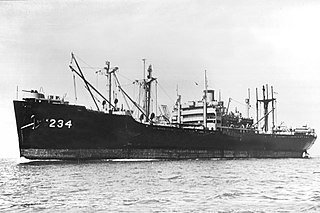
USS Bucyrus Victory (AK-234) was a Boulder Victory-class cargo ship acquired by the U.S. Navy during World War II. She served in the Pacific Ocean theatre of operations through the end of the war, earning one battle star, and then returned to the United States for disposal.

USS Knudson (APD-101), ex-DE-591, later LPR-101, was a United States Navy high-speed transport in commission from 1944 to 1946 and from 1953 to 1958.

USS Rednour (APD-102) was a Crosley-class high speed transport that served in the United States Navy from 1945 to 1946. In December 1969, she was transferred to Mexico and served as Chihuahua until July 2001.



















